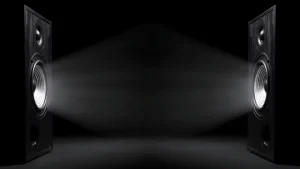Confused by RMS and speakers? No problem! This article will explain Root Mean Square (RMS). It’s a useful term for judging speaker quality. Learn how to use RMS when picking a speaker. Unlock the power of RMS now!
RMS, or Root Mean Square, is a metric used to measure a speaker’s power-handling capability. It gauges the speaker’s ability to take in audio signals without distortion.
Speakers are rated by their RMS power output – the energy they can produce with minimal distortion. RMS is compared to peak signals and is seen as an indication of the energy a speaker can handle at any moment.
RMS stands for Root Mean Square, which is a mathematical expression of ‘energy’ or ‘power’. It is used to evaluate the power of a speaker and its ability to handle audio signal power without distorting it. Generally, speakers with higher RMS ratings (greater than 400 watts) can produce clean sound for longer periods compared to those with lower ratings (lesser than 160 watts).
In This Article:
What is RMS and How Does it Work?
RMS (Root Mean Square) is a term used to rate a speaker’s power-handling capabilities. It is a measurable value used to compare different speakers. RMS measurement requires a dynamic test signal over an extended period of time, as the speaker may handle peaks in power with ease, but if the average level of the signal is too high, it can cause distortion or damage.
RMS ratings represent the maximum continuous audio power output of a speaker. It is important to note that these ratings are meant as starting points for comparison. A higher RMS rating does not guarantee the better sound quality, however, choosing a model with an adequate RMS rating will ensure the speaker can efficiently handle whatever you throw at it! So when buying speakers, don’t skimp on this point!
RMS in Speaker Technology
When it comes to speakers, RMS stands for Root Mean Square. This term rates a speaker’s ability to handle audio signal power. Specifically, the RMS value measures how much power the device sends to an amplifier or receiver for sound. It’s an important figure to consider when looking at speakers and one of the main factors that affect their sound quality.
RMS measures audio power well because it takes into account different levels of loudness across sounds within a range. Along with Watts and Hertz, RMS measures the average power sent by the speaker. This indicates if it can handle strong bass and high-pitched treble. RMS ranges from five to 100 watts per channel depending on the model and size.
No single measurement can perfectly capture audio quality. Experienced audiophiles usually choose speakers based on personal preference, not just RMS ratings. Listening tests are the best way to determine if a set has good acoustics and clear tones across all levels. Ultimately, choosing a great speaker is about finding one that delivers excellent sound for your needs, no matter its RMS rating.
Benefits of RMS in Speakers
Understanding RMS is essential when picking audio equipment. It reveals the power managing capacity of a speaker and is the most accurate measure of its power abilities. With a good understanding of RMS, you can make sure the equipment you’re buying can provide high-quality sound without distorting or breaking.
RMS stands for Root Mean Square. It measures electrical power using an RMS voltage amplifier. This calculates the squared root of the arithmetic mean. This electrical power measurement shows how much “continuous” or “average” sound a speaker can take in a period of time without getting damaged. Meaning, an amplifier does not need to deliver peak power consistently. This kind of power output could damage any speaker system.
RMS gives speakers more stability through all frequencies. It also provides better protection for both speakers and amplifiers from potential harm. Using this rating allows customers to better work out what kind of speakers they will need. This will provide enough audio signal strength for their use without causing damage due to too many watts of handling. This makes it easier to buy compatible components that last longer and still provide loud, clear sound levels while decreasing distortion at higher volumes.
Factors to Consider When Choosing an RMS Speaker
When buying speakers, RMS is key. RMS stands for Root Mean Square and is a measure of a speaker’s ability to handle audio signal power. It’s the most accurate way to judge a product’s performance, as different testing conditions lead to varied results.
Look for a pair of speakers with an RMS rating that meets your needs. Usually, the higher the rating, the better the sound quality. If you’re using multiple speakers in a home theater or outdoor entertainment system, make sure they all have similar RMS ratings. Different-sized rooms require differing amounts of power.
When shopping for speakers, pay attention to RMS ratings and make sure all pieces are compatible. With the proper research, you can get high-end quality speakers that provide clear sound and ample power handling for years to come.
Challenges with RMS Speakers
Three challenges come with using RMS speakers: power handling, durability, and audio fidelity.
- Power handling is vital, as it tells you the highest sound volume the unit can manage without getting damaged. The RMS rating or Root Mean Square rating of a full-range loudspeaker will show you this.
- Durability depends on how tough the materials are; it decides how well they survive wear and tear.
- Audio fidelity refers to how accurately an audio signal is reproduced. This involves frequency response, dynamic range, crossovers (for multi-way speakers), and distortion levels.
For the best performance from RMS speakers, look for models with good power handling ratings that fit your use and budget. Make sure durable materials are used in their construction – so they last longer. Check that all components provide excellent fidelity – for clarity and realistic sound reproduction.
Conclusion
RMS stands for Root Mean Square. It rates a speaker’s power to handle audio signals. To calculate this, take the square root of the average amplitudes (squares) of an audio signal over time. It tells you how much power your speaker can handle, so you pick one that fits your needs.
Note: RMS ratings vary between speakers. To get the best sound, choose one with an RMS rating higher than your maximum volume requirements.




